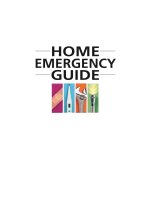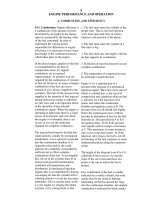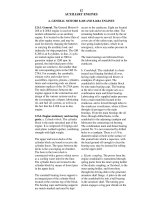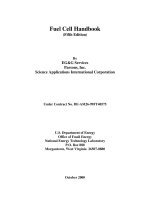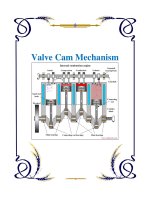Tài liệu Gree office guide docx
Bạn đang xem bản rút gọn của tài liệu. Xem và tải ngay bản đầy đủ của tài liệu tại đây (270.39 KB, 39 trang )
How to Transform your Office
into one that’s
Kinder to the Environment.
Published by
The Green Office Guide proudly supported by
This guide is produced by the
Auckland Environmental Business Network Inc.
PO Box 147 263
Ponsonby
Auckland
New Zealand
09 817 2622
1A Scotland Street
Freemans Bay
Auckland
New Zealand
www.aebn.pl.net
This guide is also available on-line at www.greenoffice.org.nz, along with a
directory of suppliers of eco-products and services.
The AEBN’s team, Rachel Brown, Caroline Peacock produced the information
contained in the guide with editing support from:
Andrew Reeve – Sinclair Knight Merz
Lisa Martin – URS
Wendy Levi – Meritec
Simon Stockdale – Sustainability 21
The AEBN wishes to thank the following sponsoring organisations for their
support in producing this guide:
Auckland City Council
Auckland Regional Council
BRANZ
EECA
Fuji Xerox
Interface Agencies
Ministry for the Environment
We also wish to thank the great number of organisations and individuals, too
numerous to mention, for their contribution to the guide.
Important Note:
While the AEBN has made reasonable endeavours to ensure the accuracy of the
information in the Green Office Guide, it cannot be held responsible for any errors
and omissions and under no circumstances shall be held liable for any injury,
damage, costs or financial loss resulting from the use of this information.
Version 1.02– 2 June 2002
© Auckland Environmental Business Network 2002
Contents
Staff Café or Kitchen................................................................ ..1
Fitting Energy and Water Efficient Appliances & Fixtures...................1
Choose Energy and Water Efficient Appliances........................................... .................1
Reduce the Volume of Water.............................................................................. ..........2
Supplying Organic Foods..................................................................2
Buying Locally Made................................................................. ........2
Reducing packaging............................................ .............................2
Recycling Kitchen Waste ....................................................... ...........3
Guidelines for Caterers......................................................... ............3
Office Equipment, Furniture & Stationery............................ ........4
Key Issues to Consider when Purchasing...........................................4
Rules of Thumb for Purchasing Office Equipment...............................5
Choose Equipment that is Designed to Last.......................................................... .......5
Pay only for the Features you Really Need................................................. ..................5
Is Leasing a Better Option?...................................................................... ....................5
Choose the Right Equipment Mix.............................................................. ...................5
Buy New Zealand made............................................................................... ................5
Use Equipment Wisely.................................................................... .............................5
Have a Regular Maintenance Schedule for Equipment.......................................... .......5
Turn Equipment off when Not In Use........................................................... .................6
Choosing a computer............................................................... .........7
Specify What you Want............................................................................... .................7
Make sure you can UPGRADE your Computer..............................................................7
Check Warranties and Service Support.................................................... ....................7
Which Manufacturer?............................................................................... ....................7
Buying Second-hand computers...................................................... ............................8
Reusing Disks and CDs.....................................................................8
Choosing Photocopiers.......................................... ...........................8
Getting rid of your old Photocopier....................................................... .......................8
Choosing a Printer......................................................................... ...8
Choosing a Fax...................................................................... ...........9
Improve Indoor Air Quality & Reducing Electromagnetic Fields...........9
Office Furniture................................................................. .............10
Second hand dealers................................................................. ................................10
Issues for new furniture............................................................... ..............................10
Desks.......................................................................................................... ...............10
Solid Wood Desks.................................................................................................. .....10
Particleboard Furniture...................................................................................... .........10
Chairs......................................................................................................................... 10
Stationery............................................................................. .........10
Paper......................................................................................................................... .10
Letterhead, Business cards and other printed materials...................11
Reassess if you really need to print! .................................................. .......................12
© Auckland Environmental Business Network 2002 Page i
Design your Document to reduce waste:............................................ .......................12
Specify 'Green' Printing:..................................................................................... ........12
Tell others about it!................................................................................... .................12
Paper Correction Fluid.................................................................................... ............12
Envelopes........................................................................................ ..........................12
Folders, file boxes, dividers etc................................................................. .................13
Indices & post-its............................................................................. ..........................13
Pens & Pencils................................................................................................ ............13
Pen holders............................................................................................ ....................13
Mobile phones....................................................................... .........13
Health..................................................................................................... ...................13
Environment................................................................................. .............................13
Cameras.................................................. ......................................14
Battery Powered Electrical Equipment.............................................14
Diaries........................................................................................ ...............................14
Sticky Tape....................................................................................................... ..........14
Stapler................................................................................................. ......................14
Rubber Stamps & Ink........................................................................ .........................14
Storage Boxes (or Gift boxes)................................................................................. ....14
Ten Simple Steps................................... ..................................15
1- Measure how much you use & how much you waste!....................15
2- Save paper ~ Think before you print. ..........................................15
3- Save toner............................................. ....................................16
4 - Save energy................................................... ...........................16
5- Recycle as much as you can!.......................................................16
6- Share Stationery........................................................................16
7- Re-use Office Supplies ...............................................................16
8- Buy Recycled Products...................................................... ..........17
9- Return to Sender.................................................... ....................17
10 - Share Ideas and Keep Improving.............................................. .17
Bathroom......................................................... .......................18
Upgrade Lighting........................................................................... .18
Check for Leaks.................................................................. ............18
Reduce volume of water in toilets...................................................18
Reassess Urinals, Showers & Taps...................................................18
Look for Efficient Ways of Drying Hands..........................................19
Cotton Hand Towels..................................................................... ..............................19
Electric Hand Dryers............................................................................ ......................19
Disposable Paper Towels....................................................................... .....................19
Cleaners and Cleaning Services................................................20
Maximise Personal Health and Safety..............................................20
Minimise Environmental Impacts. ..................................................20
© Auckland Environmental Business Network 2002 Page ii
Minimise Packaging........................................................ ................20
Avoid Synthetic Dyes & Fragrances.................................................21
Environmental Label Accreditation..................................................21
Look for Safe alternatives................................................ ...............21
Building, Surrounds & Fittings...................................... ............22
Get the Location Right................................................... .................23
Design for the Sun....................................................................... ...23
Minimise Earthworks......................................................................23
Minimise Construction Waste..........................................................24
Design to Minimise Waste.......................................................................... ................24
Dealing With Waste............................................................................................ ........24
Choose Materials Carefully........................................................... ...24
Timber......................................................................................... ..............................24
Alternative Energy Sources......................................................26
Sun Power............................................ .........................................26
Lighting............................................. .....................................27
Conduct a Simple Audit............................................................... ....27
Assess Lighting Requirements........................................................27
Upgrade Fittings or Bulbs...............................................................27
Fit Timers or Sensors............................................................... .......28
Encourage Energy Saving Behaviours..............................................28
Heating, Ventilation and Cooling (HVAC) Systems......................28
Maximise Natural Ventilation..........................................................28
Look after HVAC Systems..................................................... ...........28
Opt for Simple Heat Exchange Systems...........................................29
Insulate your Office.................................................. ......................29
Reduce Hot Water Demand.............................................. .........29
Assess Layout & Design............................................ ......................29
Don’t use it................................................................. ...................30
Use it wisely.................................................................................. .30
Use Alternative Energy Sources......................................................30
Conserve Water.............................................. .........................30
Maintain your system.....................................................................30
Paints and Oils............................. ...........................................30
Paints...................................................................... ......................30
Oils........................................................................................... .....30
© Auckland Environmental Business Network 2002 Page iii
Floors & Coverings............................................................. ......31
Uncovered floors..................................................... .......................31
Timber Flooring ............................................................................................. ............31
Look For Forest Stewardship Council (FSC) Certification ...........................................31
Floor Coverings........................................................ ......................32
Carpets............................................................................... ...........32
About the material and the manufacturer............................................................ ......32
During its use......................................................................................................... ....32
Office Gardens.................................................................... .....33
Composting or Worm-Farming............................................................................. .......33
Reduce Stormwater Runoff................................................. ......33
© Auckland Environmental Business Network 2002 Page iv
Staff Café or Kitchen
Greening the staff café or kitchen can involve using energy and water efficient
fittings, selling locally produced organic food to composting and recycling wastes.
For more detailed information:
Fitting Energy and Water Efficient Appliances & Fixtures
Supplying Organic Foods
Buying Locally Made
Reducing Packaging
Recycling Kitchen Waste
Guidelines for Caterers
Fitting Energy and Water Efficient Appliances & Fixtures
Choose Energy and Water Efficient Appliances
Purchase AAA - ‘triple A’ and Energy Rating labelled appliances
Purchase highest possible ’A’ rating. .A dishwasher with the ‘triple A’ rating
uses water efficiently.
Purchase highest possible Energy Rating e.g. a fridge or dishwasher with more
stars uses less electricity
Buy new "Smart" appliances that use "fuzzy logic" to think ahead, e.g.
refrigerators that adjust temperatures to suit individual opening habits, or
dishwashers and washing machines that control water levels according to
load.
Build in a range hood or extractor fan to eliminate cooking smells and
moisture.
Install a switch that automatically turns storage cupboard lights on and off
when door opens and closes.
Conduct regular maintenance check-ups, checking for leaks or faulty
appliances. Make sure that staff knows who to report to if leaks are found.
Special Note:
EnergyStar features are part of the US EPA programme for office
equipment (sleep mode, power down, etc). Equipment either has
EnergyStar features, or it does not. There is no rating system as such.
EECA are the NZ agents for the US EPA for the EnergyStar programme.
The Energy Rating scheme is a different system to the EnergyStar. The
Energy Rating scheme covers actual energy consumption. It is used
mainly for white-ware and domestic appliances, but it is being expanded.
It is a combined scheme between NZ and Australia. It will be compulsory
in NZ from 1 April 2002 for shops to display the energy label all appliances
covered by the scheme.
© Auckland Environmental Business Network 2002 Page 1
Triple A - AAA is for water efficiency and does not cover energy (although
it does indirectly for the Council pumping station). AAA is about to be
upgraded to an AAAAA system. It is an Australian system for which there
is no NZ agent.
Avoid
Fridges that contain CFC’s of HCFC’s – which damage the ozone layer.
Unnecessary appliances – e.g. electric can openers.
A ‘waste disposal unit’ – they use water unnecessarily to get rid of valuable
material, which should be composted, or worm farmed!
Reduce the Volume of Water
Flow restrictions are cheap, easy to fit and reduce the water flow; not only do
you use less water but you also save energy by using less hot water. Some
companies can design packages tailored to your office requirements, ensuring
that both the temperature and flow system are appropriately controlled.
Install low flow tap systems to reduce water consumption.
A pressure limiting value can be used to reduce the pressure at the point
where the town supply enters the property, reducing the pressure to all
outlets.
Aerators are another option to consider improving the quality of water stream.
Aerators simply mix the water with air resulting in a lower flow from your tap.
Install water filters to deliver optimum quality drinking water.
Supplying Organic Foods
The Staff Café or kitchen is a great way of promoting healthy eating within your
work environment. The production of food rates pretty highly as an activity that
degrades our environment, but there are a number of things you can do to
reduce that. Organic food is not only better for you, but it is produced without the
use of toxic chemicals and pesticides, thereby protecting our environment and
also providing tastier and more nutritious food.
For further reading on diet and health www.nhf.org.nz
Also consider:
Using natural pest deterrents e.g. a Bay Leaf and herbs in dry foods to deter
weevils.
Using a food-safe to keep out insects
Buying Locally Made
Buy local fresh food that is in season. Transporting food across the country uses
energy, decreases the food's vitality and increases the chances of food wastage.
Reducing packaging
Packaging can be handy for takeaways, and a good package will avoid food
waste. However, much food is excessively packaged so consider the following:
© Auckland Environmental Business Network 2002 Page 2
Buy your beverage supplies - sugar, milk, etc. - in bulk. Avoid single serves
such as individually wrapped teabags and sugar sachets.
Bring your own! Have reusable containers and bags available for staff
takeaways.
Insulated mugs with lids will last for hundreds of coffees - that's at least a
week!
Strike a deal with a local café for staff discounts when they bring their own
containers.
Plastics can leach chemicals into food - provide glass dishes especially for
microwave heat-ups.
Choose recycled content packaging or packaging that you will be able to
recycle.
Use mugs or glasses rather than disposable cups.
Recycling Kitchen Waste
It is important to make recycling systems easy to understand and use:
Install clearly labelled storage units with an easily operated lids to simplify
waste separation of:
Food scraps
Paper/cardboard
Plastics
Aluminium or steel/tin containers.
Non recyclable waste
Make food scraps not too large
Choose a convenient, sunny place for your compost bin.
Integrate the recycling system into the kitchen design/layout.
Make sure al staff are aware of what is to be recycled and where the bins are
located.
Clearly label recycling bins and put up plenty of posters encouraging people
to recycle.
Guidelines for Caterers
If getting caterers in for a party or meeting make sure you give them clear
environmental guidelines prior to accepting their quote for work:
Supply organic, locally or New Zealand grown produce
Buy local fresh and seasonal food whenever possible
Provide food packaging that is made from paper or card or potato starch,
which are all compostable.
Separated recycling bins in café - food, paper, plastics, glass, aluminium cans
and other
© Auckland Environmental Business Network 2002 Page 3
Office Equipment, Furniture & Stationery
Keeping your office supplied with machinery & stationary can be expensive. It
also comes at a cost to the environment. Computers, copiers, printers, faxes
consume a huge amount of energy and materials when they are manufactured
and while they are used. They also create heat, which causes air conditioning
systems to work harder. Click for more information
Key Issues to Consider when Purchasing
Rules of Thumb for Purchasing Office Equipment
Choosing a Computer
Reusing Diskettes & CDs
Choosing Photocopiers
Choose a Printer
Choosing a Fax
Indoor Air Quality & Reducing Electromagnetic Fields
Office Furniture
Stationery
Mobile Phones
Cameras
Battery Powered Electrical Equipment
Key Issues to Consider when Purchasing
Greening your office challenges you to think about whether your organisations’
‘needs’ can be met in different ways.
Can we lease, share or swap instead of purchasing?
Does the product have an environmental, energy rating or water-rating label?
Does the product have EnergyStar features or a ‘sleep’ mode for when it is not
being used?
Does the supplier have good environmental credentials?
Is upgrading, reconditioning or extending the useful life of our current model a
better option?
How long will this particular product last?
Will it be easily repaired or upgraded?
Are we paying for features we don't need and won't use?
How much energy or materials will it use?
Does the product contain recycled materials?
Can this product be recycled, sold or donated when we've finished with it?
Does it come with too much packaging?
© Auckland Environmental Business Network 2002 Page 4
We’ve done some of this work for you and included suppliers in our Green Pages.
Rules of Thumb for Purchasing Office Equipment
Actively purchasing 'greener' products or services is a complex task and can be
time consuming for any purchaser making informed environmental choices.
Looking for third party accredited labels provides credible, verifiable information
on the environmental claims of products and services. If there isn’t a suitable
piece of equipment that has a eco-label, then you should consider the following:
Choose Equipment that is Designed to Last
Look for design features that support upgrade, repair and remanufacture. How
will your business needs change in the next 3 to 5 years?
Pay only for the Features you Really Need
Many offices pay extra for models with features they hardly ever use. Is it more
economical to buy a simpler model and outsource more complex or demanding
jobs?
Is Leasing a Better Option?
Leasing instead of buying outright can give your business better cash flow and
greater flexibility. An 'operating lease' (as opposed to a 'financial lease') means
the supplier has a commercial interest in maintaining your equipment!
Choose the Right Equipment Mix
The distinction between what you can do with photocopiers, printers, faxes and
computers is starting to blur. Having fewer pieces of equipment can save you
money and lessen your environmental impact.
Buy New Zealand made
Most office equipment is no longer made in New Zealand – however some is. It’s
much better to buy products that are locally made or assembled to reduce
transport.
Use Equipment Wisely
Think before you copy or print. Print using ‘draft’ feature to reduce toner use.
Turn it off when its not being used. Some printers and photocopiers can print on
both sides of the paper (duplex printing) which halves the amount of paper used
and reduces the space required in filing systems.
Have a Regular Maintenance Schedule for Equipment
Ensure that all equipment is serviced and maintained regularly to ensure
efficiency and no escape of fumes from chemicals.
Fix small problems before they become big expensive problems.
Ensure that operating equipment is in well-ventilated rooms.
Don’t forget to include the maintenance contractor on your green suppliers
list – what are their policies and practices?
© Auckland Environmental Business Network 2002 Page 5
Turn Equipment off when Not In Use
© Auckland Environmental Business Network 2002 Page 6
Choosing a computer
Some computer manufacturers are designing their computers to be easily
dissembled, or are taking responsibility of the end of life cycle of computers, and
looking at issues concerning recycling or the reusing the equipment.
Ensure that your system has EnergyStar features, and that you learn how to
enable them.
Specify What you Want
Buy a system that suits your needs – don’t buy features that you won’t use.
{Contact the Consumers Institute for more information}.
Make sure you can UPGRADE your Computer
To avoid waste and get the most from your outlay, make sure you know:
Which parts can be upgraded or expanded, memory, disk space etc?
How easy is it to access the components for repair or an upgrade?
Compact computers e.g. laptops often have limited upgrade options and can
be costly to repair than desktop models. However they do use a lot less
energy, and produce a lot less heat, which means less energy for cooling.
If the rechargeable battery in laptop computer no longer holds its charge, it
may benefit from a rejuvenation process developed by Millennium Batteries.
Check Warranties and Service Support
Check out warranty and service support offers and also find out about charges on
replacement parts after the warranty has expired. An extended warranty, if
available, can be a sound investment.
Which Manufacturer?
The Silicon Valley Toxics Coalition conducts an annual survey of computer
manufacturers and publishes a report card. The report card analyses the
information on the web-sites of computer companies to compare and measure
the environmental qualities of electronic equipment and the environmental
performance of companies. Grading environmental performance is also intended
to encourage brand-name firms to place information concerning various
attributes of corporate "clean and green" responsibility on their web-sites,
thereby allowing consumers to make more informed decisions.
In the 2001 Report Card the top manufacturers, based on their activities in the
United States, were:
1. Canon
2. Toshiba
3. IBM
4. Fujitsu
5. Sony
6. NEC
7. Hewlett -
Packard
8. Brother
9. Apple
For more information on the issues and evaluation criteria used visit
www.svtc.org.
© Auckland Environmental Business Network 2002 Page 7
Buying Second-hand computers
You may be able to buy what you want for half the price. But once again, do your
homework.
Reusing Disks and CDs
Old floppy disks, which otherwise might be called waste can be wiped and
reformatted for reuse.
Rewritable CDs are recommended as a 'low waste' tool for storing data from
regular backups.
Choosing Photocopiers
Purchasing the right photocopier, with a good service agreement, will result in
reduced paper use, air pollution and land-fill space. You also should consider if
you can share a copiers with a neighbour or whether it is more cost effective to
outsource your copying. .
The main considerations are:
Choose the right capacity. E.g. copy speed & monthly volume.
Only get the features you need – but look for opportunities to expand… Can
you add paper-handling features such as document feeders and sorters?
Compare your running costs of small copiers with larger capacity ones.
Ask your supplier if they collect or refill or recycle toner cartridges.
Look for EnergyStar energy saving features – for example a power-down
feature when the copier is not in use.
Ask for a duplexing unit (this can print on both sides of the paper).
Make sure you can use recycled paper in your copier.
Locate you copier away from workspaces to avoid ozone emissions.
Can the copier also print directly from a PC and act as a printer?
Find out if your manufacturer will recycle or remanufacture toner cartridges
before you buy.
Think about buying a second-hand or reconditioned copier. They are far
cheaper and often just as reliable for smaller volumes.
Getting rid of your old Photocopier
Contact the manufacturer first and see if they have a take back or recycling
programme; contact the Recycling Operators of New Zealand (www.ronz.org.nz) if
they don’t.
Next time make sure your supplier takes it back for remanufacture and avoid the
headache of dealing with old equipment.
Choosing a Printer
Choose a printer that is efficient with both ink (toner) and paper.
Buy a printer with a long warranty - 3 years is recommended.
© Auckland Environmental Business Network 2002 Page 8
Include a duplex (double-sided printing) facility to save paper.
Look for printers that can print multiple pages per sheet (useful for printing
presentations and large reports)
Buy an EnergyStar Rated Printer.
Make sure your ink (toner) cartridge can be refilled or remanufactured
For colour printers a separate toner cartridge for each colour (red, yellow and
cyan) may be cheaper to operate than a combined colour cartridge.
Hot tip: Generally laser printers are more expensive to buy but have a
lower cost per page than ink-jet and bubble-jet printers. Cheaper running
costs and less waste can be achieved when you buy a laser printer with
long life print drum and also buy remanufactured cartridges.
Choosing a Fax
Fax machines are a common feature in any office. Faxing itself isn’t bad, they use
minimal electricity; eliminate the need for envelopes, labels and stamps. It’s just
how you fax that makes the difference.
Buy a plain paper fax machine as you can use Goose (Good on one-side) paper in
them.
Use a recycled fax paper
Can you send and receive faxes direct from PC and avoid the need for a fax
machine altogether? (Often an old PC can be re-used as a fax server)
Design small cover sheet or don’t use one at all!
Improve Indoor Air Quality & Reducing Electromagnetic Fields
Buy products that have low or no formaldehyde, trichloroethylene or benzene
in them.
Put air cleaning plants in your office some of the recommended indoor
varieties are: Peace Lilly, Dracina, mother-in-law’s tongue, English ivy, Chinese
fern, parlour palms. If you have more light then choose spider plants or
flowering plants (e.g. chrysanthemums or azaleas)
Ensure sufficient air exchange through good ventilation. No matter how hard
you try there will always be indoor air pollutants. It is important that they can
escape from the building. (Contact BRANZ for information on Building code
regulations)
Use cleaning agents that are low in volatile organic content (check out the
product label for VOC content)
For those concerned about electromagnetic fields, (these are created by any
electricity – copiers, computers etc.), consider the following:
Smart wiring using low voltage electronic signals from switches to a centrally
controlled computer.
Increase your own distance from the source (e.g. computer screen). E.g.
Design light fittings at least one metre apart and at least one metre from
people.
© Auckland Environmental Business Network 2002 Page 9



